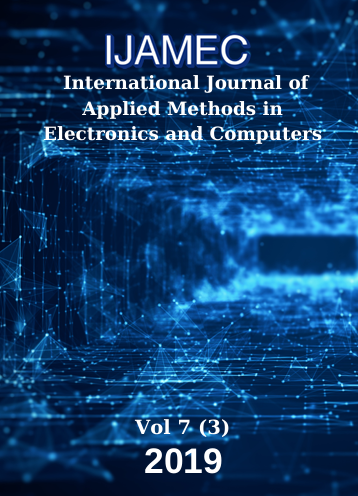Selection of Optimum Mother Wavelet Function for Turkish Phonemes
DOI:
https://doi.org/10.18100/ijamec.556850Keywords:
Discrete wavelet transform, energy, entropy, information theoretic measure, mother wavelet selectionAbstract
In this paper, we propose the selection of most suitable mother wavelet function for Turkish phonemes using discrete wavelet transform. The determination of most similar mother wavelet function to the signal has been a challenge in speech processing. The optimum mother wavelet function for Turkish phonemes have been determined by using quantitative measures which are energy and Shannon entropy, information theoretic measures which are joint entropy, conditional entropy, mutual information, and relative entropy from wavelet coefficients of the phonemes. In this study, 101 potential functions were investigated to determine the most appropriate mother wavelet. Experimental results show that the most appropriate wavelet functions for /ç/ and /ş/ phonemes which are unvoiced fricatives have been found as Bi-orthogonal 3.9 and Bi-orthogonal 5.5, respectively. By considering all the results, it is seen that the Bi-orthogonal 3.1 and Discrete Meyer wavelet functions are the most suitable mother wavelets for all other phonemes.Downloads
References
K.N. Stevens, “Acoustic phonetics”, vol. 30, MIT press, 2000.
J. Laver, “Principles of phonetics”, Cambridge University Press, 1994.
J. Clark, C. Yallop and J. Fletcher, “An introduction to phonetics and phonology”, Foreign Language Teaching and Research Press, 2007.
A. Acar, M. Cayonu, M. Ozman and A. Eryilmaz, “Changes in acoustic parameters of voice after endoscopic sinus surgery in patients with nasal polyposis”, Indian Journal of Otolaryngology and Head & Neck Surgery, vol. 66, no. 4, pp. 381–385, 2014.
Y. R. Oh, J. S. Yoon and H. K. Kim, “Acoustic model adaptation based on pronunciation variability analysis for non-native speech recognition”, Speech Communication, vol. 49, no. 1, pp. 59–70, 2007.
T. O. Lentz and R. W. Kager, “Categorical phonotactic knowledge filters second language input, but probabilistic phonotactic knowledge can still be acquired”, Language and speech, vol. 58, no. 3, pp. 387–413, 2015.
J. J. G. Meil an, F. Martinez-Sanchez, J. Carro, D.E.Lopez, L. Millian Morell and J. M. Arana, “Speech in alzheimer’s disease: Can temporal and acoustic parameters discriminate dementia? ”, Dementia and Geriatric Cognitive Disorders, vol. 37, no. 5-6, pp. 327–334, 2014.
S.-M. Lee and J.-Y. Choi, “Analysis of acoustic parameters for consonant voicing classification in clean and telephone speech”, The Journal of the Acoustical Society of America, vol. 131, no. 3, pp. 197-202, 2012.
P. Bhatia, J. Boudy and R. V. Andreao, “Wavelet transformation and pre selection of mother wavelets for ecg signal processing”, in Proc. of the 24th IASTED international conference on Biomedical engineering, pp. 390–395, 2006.
Z. Chen, Y. Liu, Z. Liu and H. Tang, “The selections of wavelet function in singular signal detection”, in Proc. of the 2nd international conference on computer science and electronics engineering, Atlantis Press, 2013.
B. N. Singh and A. K. Tiwari, “Optimal selection of wavelet basis function applied to ecg signal denoising”, Digital signal processing, vol. 16, no. 3, pp. 275–287, 2006.
A. P. Bradley and W. Wilson, “On wavelet analysis of auditory evoked potentials”, Clinical neurophysiology, vol. 115, no. 5, pp. 1114–1128, 2004.
J. Rafiee, M. Rafiee, N. Prause and M. Schoen, “Wavelet basis functions in biomedicalsignal processing”, Expert Systems with Applications, vol. 38, no. 5, pp. 6190–6201, 2011.
R. Behroozmand and F. Almasganj, “Optimal selection of wavelet-packet-based features using genetic algorithm in pathological assessment of patients speech signal with unilateral vocal fold paralysis”, Computers in Biology and Medicine, vol. 37, no. 4, pp. 474–485, 2007.
J. I. Agbinya, “Discrete wavelet transform techniques in speech processing”, in Proc. IEEE TENCON, 1996, pp. 514–519.
Y. Long, L. Gang and G. Jun, “Selection of the best wavelet base for speech signal”, in Intelligent Multimedia, Video and Speech Processing, 2004, pp. 218–221.
R. X. Gao and R. Yan, “Wavelets: Theory and applications for manufacturing”, Springer Science & Business Media, 2010.
P. D. Swami, R. Sharma, A. Jain and D. K. Swami, “Speech enhancement by noise driven adaptation of perceptual scales and thresholds of continuous wavelet transform coefficients”, Speech Communication, vol. 70, pp. 1–12, 2015.
M. A. Oktar, M. Nibouche and Y. Baltaci, “Speech denoising using discrete wavelet packet decomposition technique”, in Signal Processing and Communication Application Conference (SIU), 2016, pp. 817–820.
S. G. Mallat, “A theory for multiresolution signal decomposition: the wavelet representation”, IEEE transactions on pattern analysis and machine intelligence, vol. 11, no. 7, pp. 674–693, 1989.
N. Ahuja, S. Lertrattanapanich and N. Bose, “Properties determining choice of mother wavelet”, IEE Proceedings Vision, Image and Signal Processing, vol. 152, no. 5, pp. 659–664, 2005.
W. K. Ngui, M. S. Leong, L. M. Hee and A. M. Abdelrhman, “Wavelet analysis: Mother wavelet selection methods applied mechanics and materials”, Trans Tech Publ, pp. 953–958, 2013.
T. M. Cover and J. A. Thomas, “Elements of information theory”, John Wiley & Sons, 2012.
Z. I. Botev, J. F. Grotowski, D. P. Kroese et al., “Kernel density estimation via diffusion”, The Annals of Statistics, vol. 38, no. 5, pp. 2916 2957, 2010.
J.-N. Hwang, S.-R. Lay and A. Lippman, “Nonparametric multivariate density estimation: a comparative study”, IEEE Transactions on Signal Processing, vol. 42, no. 10, pp. 2795–2810, 1994.
Downloads
Published
Issue
Section
License
Copyright (c) 2019 International Journal of Applied Methods in Electronics and Computers

This work is licensed under a Creative Commons Attribution-ShareAlike 4.0 International License.





